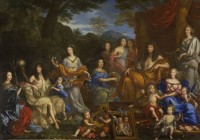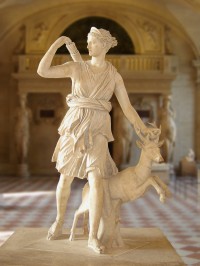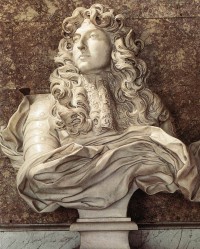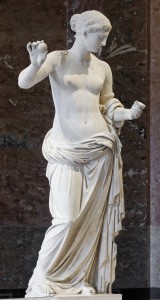 King Louis XIV, a believer in the theory that kings are chosen by God and rule by divine right, adopted the iconography of classical antiquity to convey his godlike power. As a youth, while still under the regency of his mother, Anne of Austria (who had ceded control to Cardinal Mazarin), he went to a masquerade dressed as the sun, with rays around his head and gold dust on his face. He thereafter adopted the sun as his seal. After Mazarin died in 1661 and Louis acceded to his full power as King of France, he commissioned artists like Jean Nocret and Charles Le Brun to depict him as the deified rulers of antiquity or as the deities themselves, preferably Apollo, the Greek and Roman god of the sun, bringer of heat and light to the world.
King Louis XIV, a believer in the theory that kings are chosen by God and rule by divine right, adopted the iconography of classical antiquity to convey his godlike power. As a youth, while still under the regency of his mother, Anne of Austria (who had ceded control to Cardinal Mazarin), he went to a masquerade dressed as the sun, with rays around his head and gold dust on his face. He thereafter adopted the sun as his seal. After Mazarin died in 1661 and Louis acceded to his full power as King of France, he commissioned artists like Jean Nocret and Charles Le Brun to depict him as the deified rulers of antiquity or as the deities themselves, preferably Apollo, the Greek and Roman god of the sun, bringer of heat and light to the world.
The metaphor extended to political reality with the construction of the Palace of Versailles. Louis XIV deliberately had the palace built outside of Paris in what was then a sleepy village, so it wouldn’t be an easy target for the Parisian mobs like the one that had burst into his bedroom in the Palais-Royal when he was 10 years old. By 1682, Versailles was the epicenter of royal power. France’s greatest nobles, who only a few years earlier had fought hard for their feudal rights against an increasingly centralized monarchy during the civil wars of the Fronde, now lived at Versailles at the king’s beck and call. He was the sun and they revolved entirely around him. Feudal lords who had once ruled their own domains and fielded personal armies now vied with recently ennobled courtiers to perform servile duties for the monarch.
 Although some of his ancestors, most notably Francis I, had purchased large numbers of ancient sculptures from Italy, these collections had been dispersed during the reigns of subsequent uninterested and perpetually broke monarchs. He only inherited one life-sized Roman marble, Artemis with a Deer, now in the Louvre Museum. The rest of his decor was paintings and tapestries, many of them featuring him in the guise of the heroes of classical antiquity.
Although some of his ancestors, most notably Francis I, had purchased large numbers of ancient sculptures from Italy, these collections had been dispersed during the reigns of subsequent uninterested and perpetually broke monarchs. He only inherited one life-sized Roman marble, Artemis with a Deer, now in the Louvre Museum. The rest of his decor was paintings and tapestries, many of them featuring him in the guise of the heroes of classical antiquity.
He realized that wasn’t enough cachet for him when the Baroque master Gianlorenzo Bernini came to Paris in 1665 when Louis was 27 years old. Bernini was invited to present a new design for the east facade of the Louvre, then a royal palace, but his vision did not meet with Louis’ approval. Instead, Bernini made a bust of the king which did meet with his approval and many other art lovers’ approvals in the centuries since. It’s considered a masterpiece of Baroque sculptural portraiture. Louis sat for Bernini 13 times during the making of this piece, and the artist also followed him around to convey the great man in action.
 He saw little greatness in the king’s living quarters, however. Bernini publicly declared that “the ornaments of this chamber and the adjoining rooms are ornaments for ladies.” Wounded to the core by this iceburn, Louis spent the rest of his days accumulating life-sized and colossal ancient sculptures or commissioning copies thereof. Soon his vast new digs at Versailles would require filling, and what better stage for a display of (manly) power through art.
He saw little greatness in the king’s living quarters, however. Bernini publicly declared that “the ornaments of this chamber and the adjoining rooms are ornaments for ladies.” Wounded to the core by this iceburn, Louis spent the rest of his days accumulating life-sized and colossal ancient sculptures or commissioning copies thereof. Soon his vast new digs at Versailles would require filling, and what better stage for a display of (manly) power through art.
Much of his collection of antiquities as well as his sculptures, paintings, tapestries and other decorative pieces inspired by antiquity were removed from Versailles during the French Revolution. Whatever wasn’t tied down was divvied up to French museums and sold abroad. A new exhibition at Versailles, Versailles and Antiquity, seeks to reunite Louis’ collection with other ancien régime antiques and put them on display in ten rooms of the palace they once adorned.
 The theme is the relationship of ancient imagery to power. On loan from museums all over the country, mainly the Louvre, the pieces will be returned to the exact locations they occupied during the reigns of Louis XIV, XV and XVI. Artemis and her deer have returned, as have the Venus of Arles and Hermes the Sandalbinder, who was mistakenly thought to be Cincinnatus for many years and had a plowshare added to represent the Roman hero who saved his country and then rejected power to go back to his farm.
The theme is the relationship of ancient imagery to power. On loan from museums all over the country, mainly the Louvre, the pieces will be returned to the exact locations they occupied during the reigns of Louis XIV, XV and XVI. Artemis and her deer have returned, as have the Venus of Arles and Hermes the Sandalbinder, who was mistakenly thought to be Cincinnatus for many years and had a plowshare added to represent the Roman hero who saved his country and then rejected power to go back to his farm.
“The castle finds its splendour,” said museum president Catherine Pegard. “It is of great emotional impact: past masterpieces are returning in their place thanks to the magic of Italian theatre director Pier Luigi Pizzi who has been in charge of the scenery. It is not just an exhibit, this is theatre: we are projected to the apartment of the king, in the intimacy of the art collector.”
“I tried to build a dialogue between a great king such as Louis XIV and the masterpieces on display, making them re-live in a precise atmosphere which corresponded to the spirit of the XVII and XVIII centuries,” observed Pizzi. “It was very much an issue of stage design, the set here was as important as in theatre. It was necessary to adapt the rooms of the royal palace to the context of the collection.”
The Milanese director covered the walls in a burgundy fabric and created imaginary boiseries and doors. “Evoking antiquity entails bringing to mind a certain classicism which influenced the whole style of Louis XIV. His collections needed to find a certain environment. I tried not to make it look like a makeshift environment and preferred to leave the sense of the palace as if objects found their natural collocation, instead of putting them on display as is usually done.”
The exhibition runs from November 13th, 2012 to March 17th, 2013. Versailles’ YouTube channel will post a series of six short videos about the role of antiquities in palace history. So far only one video has been uploaded, but it starts with Francis I and ends with the Bernini burn so it’s a good one.
[youtube=http://www.youtube.com/watch?v=1Fs0QZ73Uh8&w=430]
Ornaments for ladies? Now all I can imagine is poor Louis crying over his many Lisa Frank unicorn binders and posters, tearing them down angrily in a hissy fit.
The idea of Louis in a hot pink room covered with posters of unicorns and stuffed animals (toy animals, not real stuffed ones) crying because his new best friend doesn’t find his room manly enough is priceless 😆
Ah! So Pier Luigi Pizzi is at it again! Back in 1997-98, he did “Magnficenza alla Corte dei Medici: Arte a Firenze alla fine del Cinquecento”(Magnificence at the Court of the Medici: Art in Florence at the End of the Sixteenth Century)in the Museo degli Argenti on the ground floor of the Pitti Palace. That was one of the most stunningly gorgeous and historically nonsensical shows that I have ever seen. Basically, Pizzi was allowed to run wild through the various Florentine museums, grabbing the most “magnificent” mannerist objects and then creating brilliantly willful constructions because he bloody well felt like it. And if you think I was jealous, you’re right!